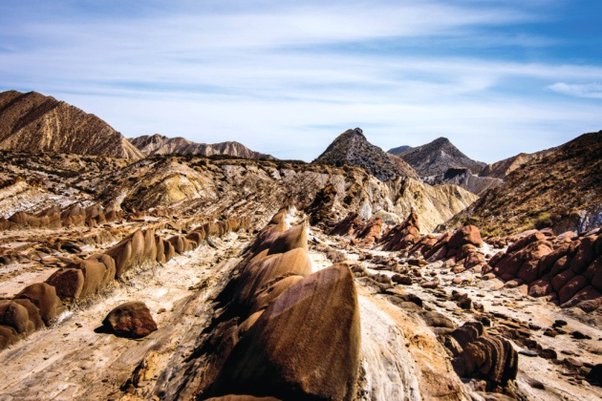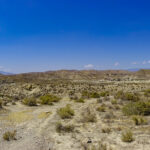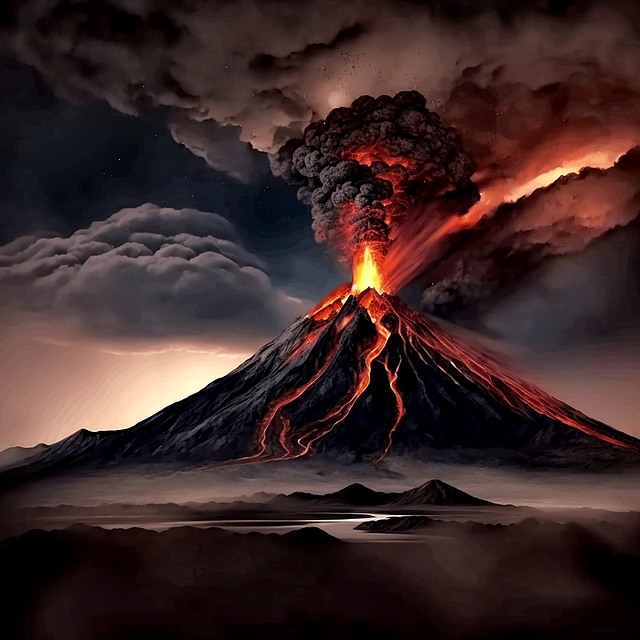Why Are Other Deserts in Europe Not Seen as True Deserts?

When discussing deserts, it is essential to understand the specific criteria that define a true desert hence the question: Why Are Other Deserts in Europe Not Seen as True Deserts? Other deserts in Europe are not classified as true deserts due to their relatively higher annual precipitation levels, typically exceeding the threshold of 250 millimeters, and their more diverse vegetation cover, which distinguishes them from the sparse and specialized flora found in true desert environments.
Scientifically, true deserts are regions characterized by extremely low annual precipitation, typically less than 250 millimeters, coupled with high evaporation rates that exceed the amount of rainfall and that is why Tabernas Desert of Almería, Spain
These conditions create an arid climate with sparse vegetation and soil that is predominantly dry, sandy, and rocky. In Europe, several regions are often referred to as “deserts” due to their dry and barren appearance.
However, these areas do not meet the stringent climatic and environmental criteria required to be classified as true deserts.
Common misconceptions about European “deserts” arise from their visual similarity to desert landscapes, leading to their misclassification.
Distinguishing true deserts from semi-arid regions is crucial for understanding their ecological dynamics, potential vulnerabilities to climate change, and the appropriate conservation measures needed to preserve their unique characteristics.
By examining the climatic conditions, geographic and environmental factors, and specific examples of these regions, we can better appreciate why they do not qualify as true deserts and why this distinction is important for scientific and environmental purposes.
Definition of a True Desert
A desert is a geographical region characterized by extremely low levels of precipitation, typically receiving less than 250 millimeters (10 inches) of rainfall annually.
Deserts are defined by their arid climate, which features high temperatures, low humidity, and limited vegetation.
These regions often exhibit vast expanses of barren or sparsely vegetated landscapes, with soil that is dry, sandy, and rocky.
Deserts can be found on every continent and are classified into several types, including hot deserts, cold deserts, coastal deserts, and semi-arid deserts, each with its own unique environmental characteristics.
A dessert should and must have the following features:
Low Annual Precipitation (Less than 250 mm): True deserts are defined by their very low annual precipitation levels, typically receiving less than 250 millimeters (10 inches) of rainfall each year.
High Evaporation Rates: In addition to low precipitation, true deserts experience high rates of evaporation, where the amount of moisture lost to the atmosphere exceeds what is received through rainfall.
Arid Climate and Specific Soil and Vegetation Characteristics: True deserts have arid climates with extreme temperatures and soils that are dry, sandy, and rocky, supporting only sparse and specialized vegetation adapted to such conditions.
Overview of the Concept
Common Misconceptions About European “Deserts”: Many regions in Europe are often mislabeled as deserts due to their dry and barren appearances, but they do not meet the strict climatic and environmental criteria of true deserts.
Importance of Distinguishing True Deserts from Semi-Arid Regions: Accurately classifying these regions is crucial for understanding their ecology, climate, and potential impacts from environmental changes.
Climatic Conditions
Precipitation Levels
Comparison of Precipitation in Semi-Arid Regions vs. True Deserts: Semi-arid regions may receive slightly higher annual rainfall than true deserts, often exceeding 250 mm but generally below 500 mm. This difference in precipitation is a key factor in their classification.
Influence of Seasonal Variations: Many semi-arid regions experience seasonal rainfall, leading to periods of relative moisture that are absent in true deserts, which maintain consistently low precipitation year-round.
Evaporation Rates
High Rates Necessary for True Desert Classification: True deserts exhibit very high evaporation rates, driven by high temperatures and low humidity, which consistently dry out the environment.
Role of Humidity and Temperature in Evaporation: In semi-arid regions, higher humidity levels and cooler temperatures can reduce evaporation rates, preventing them from reaching the extremes seen in true deserts.
Geographic and Environmental Factors
Soil Composition
True Desert Soils: Dry, Sandy, and Rocky: Soils in true deserts are typically poor in organic material and exhibit low fertility, being predominantly dry, sandy, and rocky.
Soil Types in Other Arid Regions: Semi-arid regions may have more varied soils that can retain moisture better and support a wider range of vegetation.
Vegetation
Sparse and Specialized Vegetation in True Deserts: True deserts support very limited vegetation, often consisting of specially adapted plants like succulents and xerophytes that can survive extreme aridity.
Presence of More Diverse Plant Life in Semi-Arid Regions: Semi-arid regions can support a more diverse range of plant species, including grasses and shrubs that do not survive in true deserts.
Geographic Barriers
Impact of Mountain Ranges and Other Barriers on Local Climate: Mountain ranges and other geographic features can create microclimates by blocking moisture and altering wind patterns, affecting local precipitation and temperature.
Microclimates and Their Influence on Precipitation and Evaporation: These localized climate variations can lead to conditions that are less extreme than those found in true deserts, influencing the overall classification of the region.
Specific Examples of Other European Arid Regions
Europe is home to several arid regions that, while exhibiting dry and barren landscapes, do not meet the strict criteria for classification as true deserts.
These regions may experience relatively low precipitation and support sparse vegetation, but they differ in key climatic and environmental factors from true desert environments found in other parts of the world. Here are some specific examples:
Bardenas Reales (Spain)
Characteristics of the Region:
Located in the Navarre region of northern Spain, the Bardenas Reales is a semi-arid natural region known for its unique badlands landscape.
The region features eroded cliffs, gullies, and other geological formations, creating a visually striking environment.
Bardenas Reales is characterized by a dry climate and limited vegetation, with scrubland, grasses, and shrubs being the predominant plant species.
Why It Does Not Meet True Desert Criteria:
Although the Bardenas Reales experiences relatively low annual precipitation, it typically receives more than 250 millimeters of rainfall, exceeding the threshold for true desert classification.
The presence of diverse vegetation, including grasses and shrubs, distinguishes the Bardenas Reales from true desert environments, where vegetation is sparser and adapted to extreme aridity.
Deliblato Sands (Serbia)
Characteristics of the Region:
The Deliblato Sands is a large sand dune area located in the Banat region of Serbia, often referred to as the “European Sahara.”
The region consists of extensive sand dunes, grasslands, and scrub vegetation, creating a semi-arid landscape reminiscent of desert environments.
Deliblato Sands is home to unique flora and fauna adapted to sandy soils and dry conditions, including rare plant species and bird populations.
Why It Does Not Meet True Desert Criteria:
While the Deliblato Sands experiences arid conditions and relatively low precipitation, it does not meet the strict criteria for classification as a true desert.
The region receives more than 250 millimeters of rainfall annually, and its vegetation cover is more diverse and extensive compared to true desert environments.
Puszta (Hungary)
Characteristics of the Region:
The Puszta, also known as the Great Hungarian Plain, is a vast lowland area located in eastern Hungary, extending into parts of Slovakia and Serbia.
The region features a semi-arid climate with hot summers and cold winters, supporting grasslands, meadows, and wetlands.
The Puszta is known for its cultural and historical significance, as well as its unique biodiversity, including various plant and animal species adapted to its arid conditions.
Why It Does Not Meet True Desert Criteria:
Despite its dry and relatively barren appearance, the Puszta receives more than 250 millimeters of rainfall annually, precluding its classification as a true desert.
The region’s vegetation cover, which includes grasslands and wetlands, is more extensive and diverse compared to true desert environments, reflecting its semi-arid climate.
While these European arid regions share some similarities with true deserts, they do not meet the stringent criteria for classification as such.
Understanding the distinctions between these semi-arid regions and true deserts is essential for accurately characterizing and conserving their unique ecological and environmental attributes.
Misconceptions and Misclassifications
Popular Perceptions
Media Portrayal of European Arid Regions: Media and popular culture often exaggerate the aridity of certain European regions, leading to misconceptions about their true climatic conditions.
Historical and Cultural Influences on Perceptions: Historical accounts and cultural narratives can also shape perceptions, sometimes leading to the misclassification of regions as deserts.
Scientific Misclassifications
Early Scientific Studies and Their Limitations: Early scientific explorations may have lacked the precise measurements and criteria used today, leading to misclassifications.
Advances in Climatology and Geography Improving Classification: Modern climatology and geography have provided more accurate tools and data for distinguishing true deserts from other arid regions.
The Role of Climate Change
Changing Precipitation Patterns
Potential Future Classification of European Regions: Climate change may alter precipitation patterns, potentially leading to the reclassification of some European regions as true deserts in the future.
Current Trends in Climate Data: Ongoing monitoring of climate data is essential to understanding how these changes might affect regional classifications.
Desertification Processes
Difference Between Desertification and Natural Deserts: Desertification refers to the process by which fertile land becomes desert-like due to various factors, whereas true deserts are naturally arid regions.
Impact on European Landscapes: Desertification can significantly alter European landscapes, affecting agriculture, biodiversity, and human settlements.
Conclusion
Importance of Precise Climatic and Environmental Criteria: Accurate classification relies on strict climatic and environmental criteria, including precipitation levels, evaporation rates, soil composition, and vegetation types.
Distinctions Between True Deserts and Semi-Arid Regions: Understanding these distinctions is crucial for accurately studying and managing these environments.
Need for Accurate Classification in Environmental Science: Proper classification informs conservation efforts and ensures that appropriate measures are taken to protect these unique ecosystems.
Importance of Protecting Unique Ecosystems Within Europe: Conservation efforts must be tailored to the specific needs of semi-arid and arid regions to preserve their biodiversity and ecological integrity.
Understanding why other European arid regions are not considered true deserts highlights the need for precise scientific criteria in environmental classification. This clarity ensures that we can effectively protect and manage these unique landscapes amid changing climatic conditions









